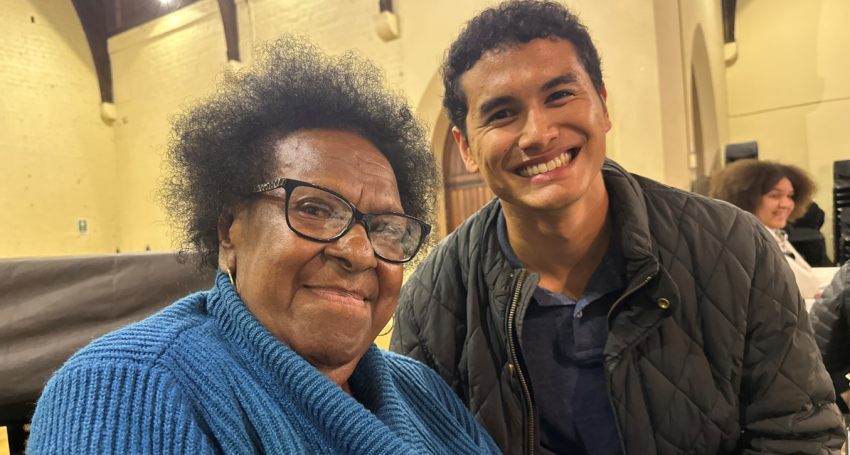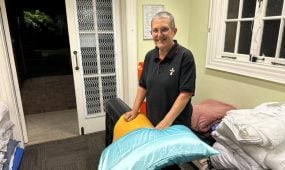Keeping the home fires burning — a very long way from home
Justice & Advocacy
“I have shared something of my culture here with you — how muiy (fire) gives physical and spiritual strength to my people. I have shared this from the warmth that I have for you in my heart. I encourage you to similarly share with someone this NAIDOC Week something of your culture, speaking from the warmth in your own heart. What keeps your pride in your culture burning?” asks Aunty Dr Rose Elu

Held across the country between Sunday 7 and Saturday 14 July this year, NAIDOC Week celebrates and recognises the histories, cultures and achievements of Aboriginal and Torres Strait Islander peoples.
NAIDOC Week can be traced back to the 1920s when First Nations peoples were campaigning for civil rights and equality. This pathoeridhay (fight) continues today, a century later.
This year’s NAIDOC Week theme is “Keep the Fire Burning! Blak, Loud & Proud”. For the National NAIDOC Committee, this theme honours the enduring strength and vitality of First Nations cultures — with fire symbolising connection to Country, to each other, and to the rich tapestry of traditions that define Aboriginal and Torres Strait Islander peoples.
Muiy (fire) is an integral part of my peoples’ living igililnga (culture). Fire gives us moegaw (strength). We need it for our gamu ay (physical sustenance) because we use fire to aymuiy (cook) with. We recognise that fire, like much of Kuiyk (Creation), is cyclical in the way it matha ngoedhagidh (nourishes) us. My gently spoken apu (mother) was a nurturer. She modelled, rather than talked about, her cultural knowledge. She showed us how to put the kunar (ashes) from a cooking fire into the apawlag (garden), knowing that wood ash contains nutrients that benefit plant growth.
Our cultural foods include bisi (casava), wapi (fish) and urugubaw (sweet potato). We like to cook our foods in woerabaw ikay (coconut milk) in an amay (earth oven). We drink ariu nguki (rainwater) and woerabaw nguki (coconut water). Everything we eat and drink traditionally is pure and alive. Nothing is refined or processed.
We also rely on fire in our buwaylthoeyay (ceremonies), including in buthpoethay (initiations). We see fire as something that pudhunga (purifies) — because thu (smoke) is purifying. We also see fire as symbolising buiya (light) — it represents the light of my mabaygal (people).
Advertisement
As Uncle Milton Walit, who is also from the chieftain crocodile clan, explains:
“On Saibai there are no rocks. While some Torres Strait Islander clans create fire by hitting two granite-like rocks together, on Saibai we create fire through a bow string, a hard stick and a piece of soft wood. We rub the stick using the bow string so it’s like a drill moving in a back-and-forth motion into the soft wood. This causes friction, which creates thu (smoke). The thu ignites the pile of woerabaw kake (coconut husk) kitupuiyang (kindling) underneath and once this catches fire, we slowly build the fire with twigs and then larger sticks and then larger pieces of wood.”

“On Saibai we create fire through a bow string, a hard stick and a piece of soft wood. We rub the stick using the bow string so it’s like a drill moving in a back-and-forth motion into the soft wood,” (drawing by Uncle Milton Walit)
So, how will you kindle the flame of unity and celebrate this year’s NAIDOC Week?
National NAIDOC Committee Co-Chair Aunty Dr Lynette Riley, a Wiradjuri and Gamilaroi elder, says this about NAIDOC Week 2024:
“The resilience of mob, our shared experiences, collective memories and kinship is a source of tremendous pride.
“We honour the flame of the fire, kindling the sparks of pride and unity, igniting a renewed commitment to acknowledging, preserving, and sharing the cultural heritage that enriches our nation.
Advertisement
“This year’s theme is a clarion call to continued unity and solidarity for all Australians to come together and celebrate.”
I have shared something of my culture here with you — how muiy (fire) gives physical and spiritual strength to my people. I have shared this from the warmth that I have for you in my heart. I encourage you to similarly share with someone this NAIDOC Week something of your culture, speaking from the warmth in your own heart. What keeps your pride in your culture burning?
I also encourage you to find out more about NAIDOC Week and about the strength and resilience of Aboriginal and Torres Strait Islander peoples — for the cultures of First Nations Australians are the oldest continuously living cultures in the world.
Editor’s note: For more information on this year’s 7-14 July 2024 NAIDOC Week, including resources, please visit the NAIDOC Week website. For liturgical resources, please visit the faithful + effective website or the ABM website.





